
JAPANESE PRINTS
A MILLION QUESTIONS
TWO MILLION MYSTERIES
Kansas City, Missouri
|
UTAGAWA YOSHIIKU 歌川芳幾 1833-1904 |
|
Subject: Kuzu no ha (葛の葉), the fox woman writing her farewell poem |
|
Actor (left panel): Sawamura Tosshō II 沢村訥升 |
|
Actor (right panel) as Kuzunoha: Bandō Hikosaburō V (1832-77) 坂東彦三郎 |
|
Publisher: Kogaya Katsugorō 古賀屋勝五郎 |
|
Date: 1865, 7th Month |
|
Sizes: Left panel - 14 1/8" x 9 1/16" Right panel - 14 1/8" x 9" |
|
Signature: Yoshiiku ga |
|
Illustrated: |
|
SOLD! |
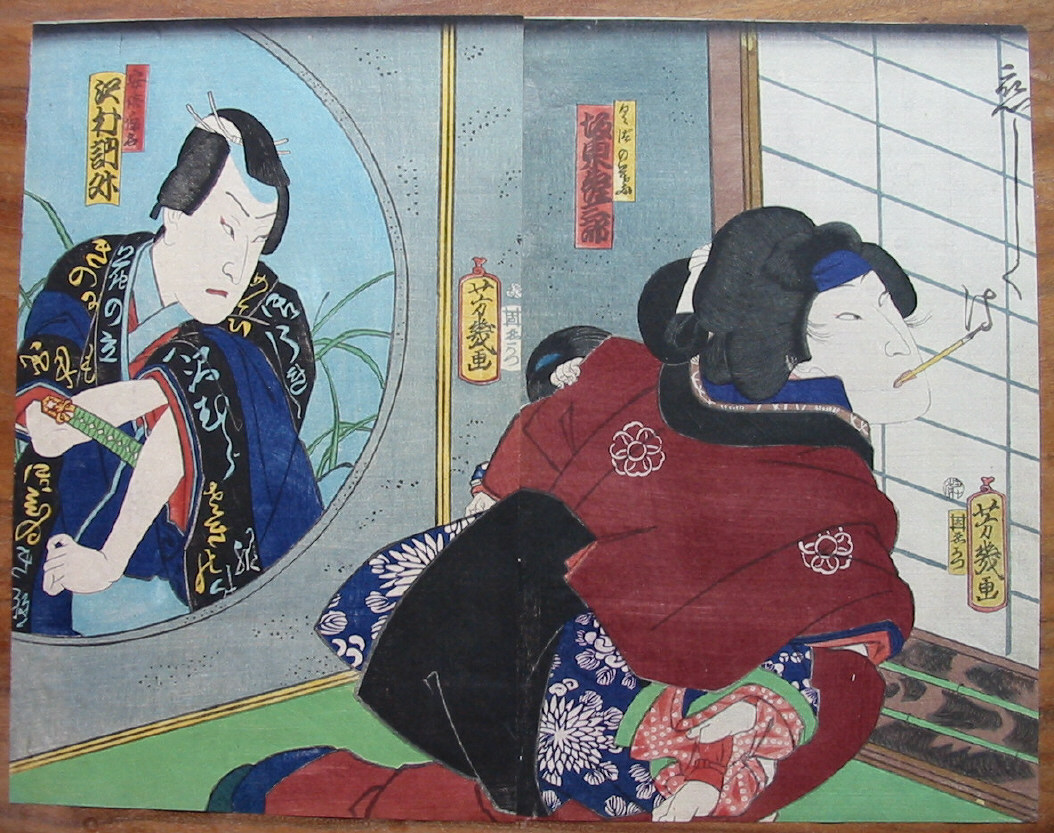 |
||
|
I CAN'T EVEN RUB MY BELLY WHILE PATTING MY HEAD OR IS IT THE OTHER WAY AROUND? |
|
|
|
Calligraphy is traditionally considered the greatest of all arts in China. In fact, it was rated higher than painting which was by some accounts the only other true art. (Some theoreticians would add poetry and/or music.) Even paintings were created with the same brushes and techniques as that used by calligraphers. All of the rules of elegant writing applied to painting - power, energy, delicacy, soul, heart, flow and chih or 'life breath', et al. The Chinese wrote on their paintings. Why? Because great writing is better than great painting and can only enhance a piece. Famous paintings which have been handed down from one important collector to another often have much of their empty spaces filled with latter day encomiums. The danger, of course, was the rooted in the vanity of owner who fancied himself a great calligrapher when in fact he wasn't. This is particularly true of one Chinese emperor who not only applied his less than desirable writing 'skills' to one masterpiece after another, but he did so on a physical scale which dwarfed that of all the previous owners.
The Japanese borrowed many things from the Chinese and their appreciation of great calligraphy was one of them. There are great masters in this art even today. That is what makes the performance of actor playing the fox mother writing a beautifully composed poem using only a brush held in the mouth that much more breathtaking.
I am right handed and would have a hell of time if for any reason trying to write things out with my left hand. I am slightly ambidextrous, but it goes no further than the use of a fork. One look at me and you could probably tell that. That is why I so admire the special skills that certain people exhibit: Great musicians, athletes artists and craftsmen. For myself I can't even rub my belly and pat my head at the same time. That is why I am that much more respectful of people like Minnesota Fats who could flawlessly sink the eight ball in the side pocket with a triple or quadruple carom shot. |
|
|
|
Above is an illustration by Hokusai from his Ehon wakan homare showing a man writing by holding some kind of woven contraption which holds the brush. The brush never touches his hand and yet the calligrapher is distinct and balanced. Try this at home yourself. I would think it would take a lot of practice. I know I couldn't do it. The image was sent to us by one of our favorite correspondents E. Thanks E!
The image shown below which is an example of calligraphic virtuosity is also by Hokusai. |
|
|
|
DID YOU NOTICE THE CHILD SHE IS HOLDING? |
|
|
|
Samuel L. Leiter in his New Kabuki Encyclopedia (p. 26) notes a separate genre of Japanese fiction referred to as irui konin banashi (いるい.こんいん.ばなし?) or "tales of marriage between animals and humans." Before you titter immaturely take a deep breath and try to think of this in terms of a sociological construct. This is not a prurient issue. It comes from a culture steeped in a deep respect for the power of all objects - both animate and inanimate. Besides, in the West we have the classic examples of "Beauty and the Beast", Bottom and Titania and Shrek and Feona. Rarely are things what they appear to be.
Before I attempt a description of the story portrayed in the diptych featured on this page I want to iterate some comments I have made about kabuki theater on other pages. Descriptions of particular themes are like the testimonials taken at the scene of an accident or crime scene. If there were a hundred people who 'actually' saw what took place one would still get one hundred variations. Well...that is somewhat what kabuki stories are like. There is no codification. There is no single interpretation. There is no single way to tell the stories. There is no solid ground beneath our feet. That does not mean that the images displayed on this page don't have a firm basis, but the problem is "Do we have an absolute idea of what it is?" Probably not. Some New Year's plays were re-scripted on an annual basis and often borrowed everything but the kitchen sink from other totally unrelated plays.
A QUICK SYNOPSIS
Our hero, Abe no Yasuna, is in love with Sakaki no Mae. She kills herself. He is driven mad and wanders about clutching her kimono until he runs into her beautiful sister Princess Kuzu no ha. That is enough to restore his sanity and he falls in love with her, but she is being pursued by her evil cousin Akuemon. The princess goes into hiding and Akuemon goes hunting for the blood of a white fox. Yasuna helps the fox escape. Akuemon and his men beat Yasuna mercilessly who is now on the verge of suicide himself. The fox takes pity on its saviour and transforms itself into the form of Princess Kuzu no ha. They get married, have a child and live happily together for five years until the real princess shows up. The faux-fox-princess tells its husband the truth and urges him and the real Kuzu no ha to raise the child as their own. Then the fox-mother writes a poem on a shoji screen by holding a brush between its teeth. "If you love me, you will seek me in Izumi's Shinoda Forest. Kuzu no ha." |
|
There are quite a few other images of the fox-Kuzu no ha writing its farewell to its child and husband. Below is a partial list in chronological order.
1. Toyokuni I (1802) 2. Toyokuni III (1850) 3. Kuniyoshi (1852) 4 & 5. Toyokuni III (1861) 6. Toyokuni III (1863) 7. Kunichika(1865) 8. Kunichika (1891)
There are many other examples, however for now this list will have to suffice giving a sense of the popularity of this theme among print makers and publishers. |
|
SOMETIMES YOU JUST CAN'T SCREEN OUT THE TRUTH |
|
|
|
|
|
|
|
Another great visual device in the portrayal of the fox-mother is the use of the shoji screen profile. The image above is a detail from a print by Kuniyoshi (ca. 1843-5) where the faux Kuzu no ha tenderly watches over its sleeping child. Nearly half a century later Kuniyoshi's most talented student, Yoshitoshi, created his own variation on the silhouetted image. Beautiful, elegant and just short of subtle. |
|
|
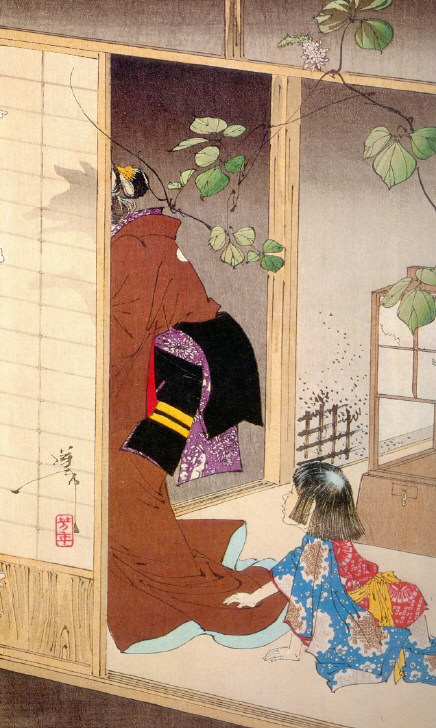 |
|
Once again we are grateful to our amazingly generous correspondent E. for sending us the Kuniyoshi image at the top of this section. Thank you E!
Shown immediately above is a Yoshitoshi print. |
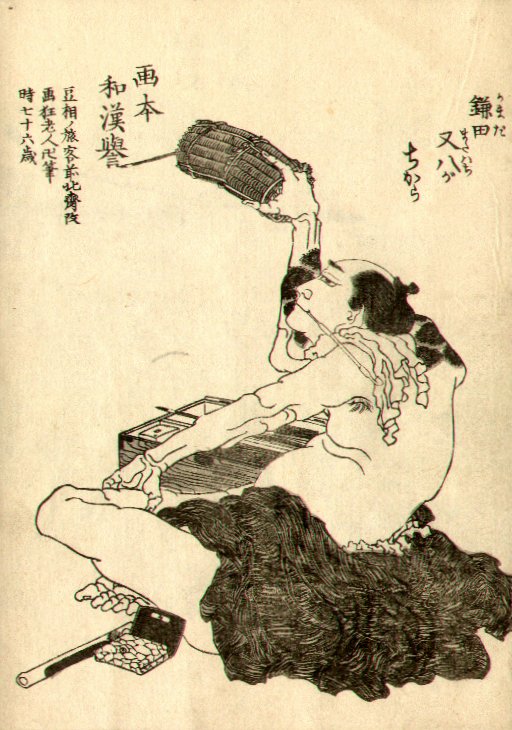
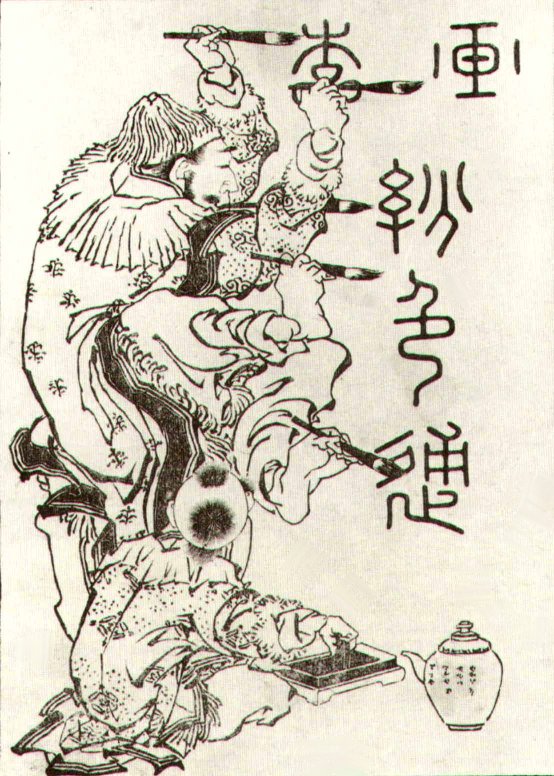
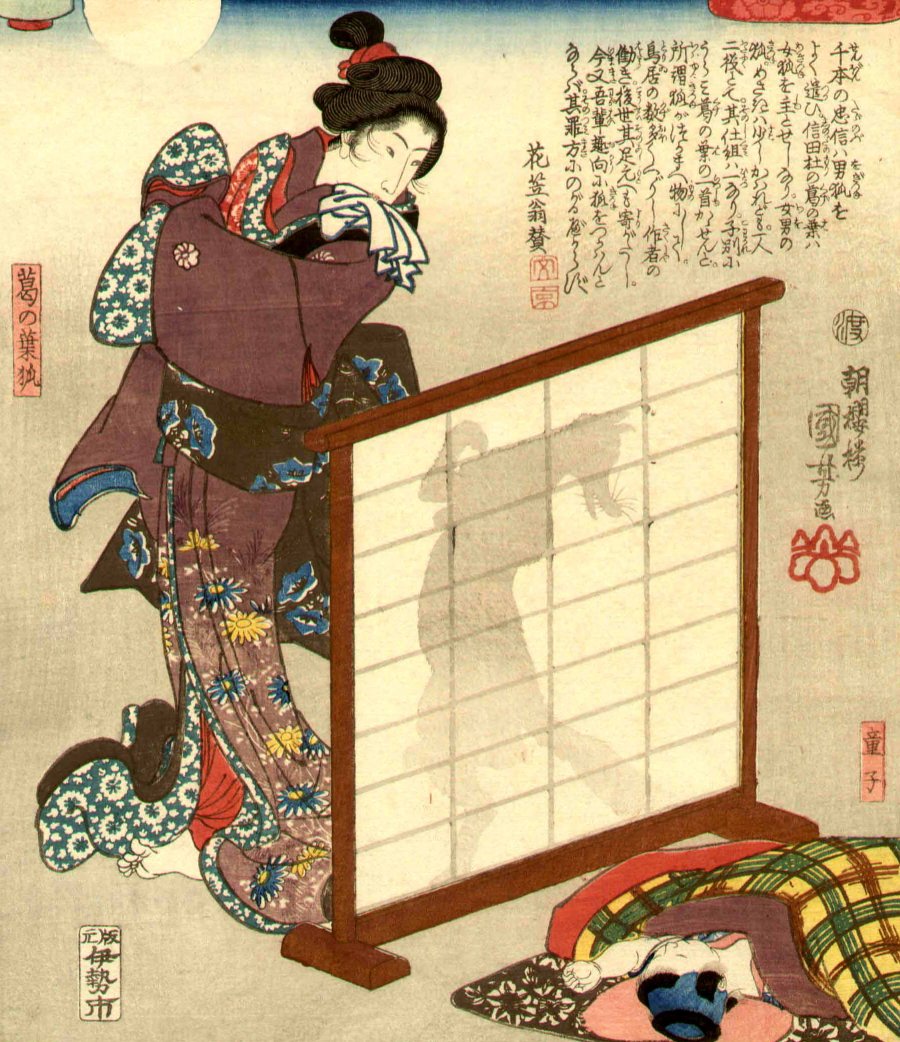
 HOME
HOME